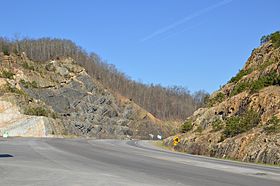Pound Gap facts for kids
Quick facts for kids Pound Gap |
|
|---|---|

Looking into the gap from the east
|
|
| Elevation | 2,392 ft (729 m) |
| Traversed by | |
| Location | Letcher County, Kentucky / Wise County, Virginia, United States |
| Range | Cumberland Mountains |
| Coordinates | 37°09′17″N 82°37′58″W / 37.1548257°N 82.6326561°W |
The Pound Gap is a special place in the Cumberland Mountains on the border between Kentucky and Virginia. It's like a natural doorway through Pine Mountain, connecting the towns of Jenkins, Kentucky and Pound, Virginia. For hundreds of years, this gap has been a very important path for people traveling between these two states. Today, a major road called U.S. Route 23 goes right through it.
Contents
A Journey Through Time at Pound Gap
Early Explorers and Pioneers
Imagine a time when Kentucky was mostly wild land! In 1750, some of the first people to explore this area for the Ohio Company might have traveled through Pound Gap. One of them was possibly a famous explorer named Christopher Gist. For the next ten years, many hunters also used this gap to go from Virginia into the rich hunting grounds of Kentucky.
A very well-known explorer, Daniel Boone, used Pound Gap in 1774. He traveled with Michael Stoner to warn land surveyors about possible attacks from the Shawnee people. Daniel Boone actually called it "Sounding Gap."
Around the year 1800, some of the very first families to settle in eastern Kentucky came through Pound Gap. These brave pioneers included the Adamses, Webbs, Caudills, Crafts, Hammonds, Sturgills, and Collinses. Many of their descendants still live in Letcher County today! Other families like the Hoggs, Maggards, Wrights, Fraziers, Fieldses, Bates, Halls, Bentleys, and Hamptons soon followed.
An Important Road for Trade
In 1834, the government of Kentucky decided to make the road through Pound Gap even better. This road, known as one of "Kentucky's Wilderness Traces," stretched all the way from Mount Sterling to Pound Gap. It made it much easier to travel to western Virginia.
This route became very popular for moving farm animals like horses, hogs, and cattle to markets in Virginia and other southern states. It was a shorter path than other options. The Mount Sterling - Pound Gap road was considered the longest state road before the American Civil War. Today, parts of modern roads like KY 11, KY 15, and US 119 follow this historic path.
The Civil War Battle
During the American Civil War, Pound Gap became a battlefield. In 1861, soldiers from the Confederate States Army, led by Colonel John S. Williams, took control of the gap.
However, on March 16, 1862, about 800 Union soldiers arrived. They were from the 42nd Ohio Infantry and were led by Brigadier General James A. Garfield. In the Battle of Pound Gap, the Union soldiers fought hard and forced the 500 Confederate soldiers to retreat. General Garfield, who was the youngest Union general at the time, became famous after this battle. He later became a president of the United States!
The Killing Rock Incident
On May 14, 1892, a sad event happened near Pound Gap. A man named Dr. M.B. Taylor, also known as "The Red Fox," and two other men, Henan and Cal Fleming, attacked a local family. This event, which resulted in the loss of five lives, took place at a rock now called "Killing Rock." Dr. Taylor was later found responsible for the deaths. Today, the area around Killing Rock is part of the Jefferson National Forest and has a hiking trail called the Red Fox Trail.
Amazing Rocks and Geology
Pound Gap is a special type of mountain pass called a wind gap. This means that streams or rivers no longer flow through it, even though they might have in the past.
When a new part of US 23 was being built in 1998, something incredible was discovered: the "Pine Mountain Pound Gap Thrust Fault." This is a huge crack in the Earth's crust! Geologists (scientists who study rocks and the Earth) believe that this fault was formed over 275 million years ago. It happened when the North American continent crashed into Africa and Europe, which also created the Appalachian Mountains.
Scientists say that the exposed rock at Pound Gap is "one of the most remarkable exposures of rock in the entire eastern United States." It's like looking at a giant history book written in stone! Because of its amazing geological features, Pound Gap was named Kentucky's first Distinguished Geologic Site on September 26, 1998, by the Kentucky Society of Professional Geologists.

